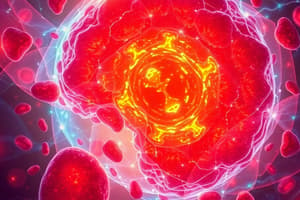Podcast
Questions and Answers
Which lymphoma is associated with a 'starry sky' appearance under the microscope?
Which lymphoma is associated with a 'starry sky' appearance under the microscope?
- Burkitt Lymphoma (correct)
- Diffuse Large B-Cell Lymphoma
- Adult T-Cell Lymphoma
- Follicular Lymphoma
What genetic alteration is most commonly associated with Follicular Lymphoma?
What genetic alteration is most commonly associated with Follicular Lymphoma?
- t(11;14)-translocation (correct)
- c-myc translocation
- BCL-2 mutation
- t(14;18)-translocation
Which type of lymphoma is considered an AIDS-defining illness?
Which type of lymphoma is considered an AIDS-defining illness?
- Cutaneous T-Cell Lymphoma
- Marginal Cell Lymphoma (correct)
- Adult T-Cell Lymphoma
- Mantle Cell Lymphoma
In which age group is Burkitt Lymphoma most commonly found?
In which age group is Burkitt Lymphoma most commonly found?
What is a common presentation found in patients with Adult T-Cell Lymphoma?
What is a common presentation found in patients with Adult T-Cell Lymphoma?
Which lymphoma subtype is characterized by mutations in BCL-2 and BCL-6?
Which lymphoma subtype is characterized by mutations in BCL-2 and BCL-6?
Marginal Cell Lymphoma may present with neurological symptoms in which patient demographic?
Marginal Cell Lymphoma may present with neurological symptoms in which patient demographic?
What is a characteristic clinical feature of Mycosis Fungoides?
What is a characteristic clinical feature of Mycosis Fungoides?
Which translocation is associated with Mantle Cell Lymphoma?
Which translocation is associated with Mantle Cell Lymphoma?
Which of the following lymphomas is endemic in Africa and associated with jaw lesions?
Which of the following lymphomas is endemic in Africa and associated with jaw lesions?
Which lymphoma subtype is characterized by a high proliferation rate due to Bcl-2 overexpression?
Which lymphoma subtype is characterized by a high proliferation rate due to Bcl-2 overexpression?
What is the common presentation in individuals with Primary CNS Lymphoma?
What is the common presentation in individuals with Primary CNS Lymphoma?
Which lymphoma is associated primarily with chronic inflammation and has a potential regression after H. pylori eradication?
Which lymphoma is associated primarily with chronic inflammation and has a potential regression after H. pylori eradication?
Which type of lymphoma is known for presenting with lytic bone lesions and hypercalcemia?
Which type of lymphoma is known for presenting with lytic bone lesions and hypercalcemia?
What age group is primarily affected by Follicular Lymphoma?
What age group is primarily affected by Follicular Lymphoma?
What is a distinctive feature of Burkitt Lymphoma upon microscopic examination?
What is a distinctive feature of Burkitt Lymphoma upon microscopic examination?
Which translocation is commonly associated with Mantle Cell Lymphoma?
Which translocation is commonly associated with Mantle Cell Lymphoma?
Which lymphoma subtype primarily affects adults and is linked with the T-cell lymphotropic virus type 1 (HTLV-1)?
Which lymphoma subtype primarily affects adults and is linked with the T-cell lymphotropic virus type 1 (HTLV-1)?
Which subtype of lymphoma is characterized by the presence of mycosis fungoides?
Which subtype of lymphoma is characterized by the presence of mycosis fungoides?
What is the typical location for lymphadenopathy in Diffuse Large B-Cell Lymphoma?
What is the typical location for lymphadenopathy in Diffuse Large B-Cell Lymphoma?
What characteristic is associated with Burkitt Lymphoma?
What characteristic is associated with Burkitt Lymphoma?
Which lymphoma type is characterized by the t(11;14) translocation?
Which lymphoma type is characterized by the t(11;14) translocation?
Which statement best describes the presentation of Diffuse Large B-Cell Lymphoma?
Which statement best describes the presentation of Diffuse Large B-Cell Lymphoma?
What is a common association of Marginal Cell Lymphoma?
What is a common association of Marginal Cell Lymphoma?
Which type of lymphoma is related to HIV/AIDS?
Which type of lymphoma is related to HIV/AIDS?
What genetic mutation is particularly noted in Diffuse Large B-Cell Lymphoma?
What genetic mutation is particularly noted in Diffuse Large B-Cell Lymphoma?
Which subtype of lymphoma presents with late-stage disease at diagnosis?
Which subtype of lymphoma presents with late-stage disease at diagnosis?
What is a distinct clinical feature of Mycosis Fungoides?
What is a distinct clinical feature of Mycosis Fungoides?
Which lymphoma is considered an AIDS-defining illness?
Which lymphoma is considered an AIDS-defining illness?
Which characteristic is most indicative of Diffuse Large B-Cell Lymphoma?
Which characteristic is most indicative of Diffuse Large B-Cell Lymphoma?
What is a common demographic for Marginal Cell Lymphoma?
What is a common demographic for Marginal Cell Lymphoma?
Which lymphoma is associated with a specific viral infection and IV drug use?
Which lymphoma is associated with a specific viral infection and IV drug use?
What type of presentation is most typical for Burkitt Lymphoma?
What type of presentation is most typical for Burkitt Lymphoma?
Which of the following is a key genetic alteration in Follicular Lymphoma?
Which of the following is a key genetic alteration in Follicular Lymphoma?
What unique feature is associated with Primary CNS Lymphoma?
What unique feature is associated with Primary CNS Lymphoma?
In which lymphoma is overexpression of Bcl-2 associated with increased cell proliferation?
In which lymphoma is overexpression of Bcl-2 associated with increased cell proliferation?
Which type of lymphoma often regresses despite H. pylori eradication?
Which type of lymphoma often regresses despite H. pylori eradication?
What condition often presents as confusion, memory loss, and seizures in the context of immune suppression?
What condition often presents as confusion, memory loss, and seizures in the context of immune suppression?
What is the typical location of the lymphadenopathy in patients with Follicular Lymphoma?
What is the typical location of the lymphadenopathy in patients with Follicular Lymphoma?
Flashcards are hidden until you start studying
Study Notes
Neoplasms of Mature B-Cells
-
Burkitt Lymphoma: Primarily affects adolescents and young adults; characterized by t(8;14) translocation affecting c-myc and heavy-chain Ig. Notable for its "starry sky" appearance under the microscope, featuring sheets of lymphocytes and "tingle body" macrophages. Commonly associated with Epstein-Barr Virus (EBV) and may present with jaw lesions. Endemic in Africa, typically affecting the abdomen or pelvis; it is the most frequent type of non-Hodgkin's lymphoma.
-
Diffuse Large B-Cell Lymphoma: Occurs in about 80% of adults and 20% of children; involves mutations in BCL-2 and BCL-6, along with t(14;18) translocation. Bcl-2 protein prevents apoptosis, leading to uncontrolled cell proliferation. Patients may exhibit fluctuating sizes of painless lymphadenopathy, characterized by "waxing and waning" symptoms.
-
Follicular Lymphoma: Found in adults, presenting with painless, slow growth; associated with t(11;14) translocation involving Cyclin D1 and heavy-chain Ig, and sometimes t(11;18). Known for its aggressive nature, patient diagnosis typically occurs in late-stage disease.
-
Mantle Cell Lymphoma: More common in adult males; originates from the mantle zone of lymphoid follicles. Associated conditions include chronic inflammation, such as Sjögren syndrome or chronic gastritis (MALT lymphoma). Interestingly, may regress despite eradication of H. pylori.
-
Marginal Cell Lymphoma: Affects adults and is considered an AIDS-defining illness. Its presentation may vary, including confusion, memory loss, and seizures. Often manifests as a single ring-enhancing CNS mass on MRI in immunocompromised individuals, necessitating differentiation from toxoplasmosis through CSF analysis and laboratory tests.
-
Primary CNS Lymphoma: Primarily occurs in adults and is associated with EBV, particularly in the context of HIV/AIDS.
Neoplasms of Mature T-Cells
-
Adult T-Cell Lymphoma: Afflicts adults, caused by the T-cell lymphotropic virus type 1 (HTLV-1). Strongly linked to intravenous drug use. Patients may exhibit cutaneous lesions and may present with lytic bone lesions and hypercalcemia. Endemic regions include Japan, West Africa, and the Caribbean.
-
Cutaneous T-Cell Lymphoma: A heterogeneous group of T-cell neoplasms affecting adults. Involves skin, blood, lymph nodes, and viscera. Notable subtype includes Mycosis Fungoides, characterized by erythematous patches that favor sun-protected areas, progressing to plaques and ultimately tumorous lesions.
Neoplasms of Mature B-Cells
-
Burkitt Lymphoma
- Primarily affects adolescents and young adults.
- Characterized by t(8;14) translocation involving c-myc (chromosome 8) and heavy-chain immunoglobulin (chromosome 14).
- Notable for "starry sky" appearance under microscopy with sheets of lymphocytes and "tingle body" macrophages.
- Commonly associated with Epstein-Barr Virus; presents with jaw lesions, especially endemic in Africa.
- Typically found in the abdomen or pelvis; most prevalent type of non-Hodgkin's lymphoma.
-
Diffuse Large B-Cell Lymphoma
- Occurs in 80% adults and 20% children.
- Genetic mutations include BCL-2, BCL-6, and t(14;18) translocation involving heavy-chain Ig (14) and BCL-2 (18).
- BCL-2 overexpression leads to reduced apoptosis and increased cell proliferation.
- Clinical presentation is marked by fluctuating painless lymphadenopathy.
-
Follicular Lymphoma
- Primarily affects adults, presenting with painless and slow growth.
- Associated with t(11;14) translocation involving Cyclin D1 (11) and heavy-chain Ig (14); can be CD5+ and t(11;18).
-
Mantle Cell Lymphoma
- More common in adult males compared to females.
- Very aggressive with late-stage presentation at diagnosis.
-
Marginal Cell Lymphoma
- Affects adults and is often associated with chronic inflammation; linked to Epstein-Barr virus and HIV/AIDS.
- Associated with conditions like Sjögren syndrome and chronic gastritis (MALT lymphoma).
- May regress following H. pylori eradication.
-
Primary CNS Lymphoma
- Primarily found in adults.
- Recognized as an AIDS-defining illness with variable presentations, including confusion, memory loss, and seizures.
- Often appears as a single, ring-enhancing CNS mass on MRI in immunocompromised patients, necessitating differentiation from toxoplasmosis through CSF analysis.
Neoplasms of Mature T-Cells
-
Adult T-Cell Lymphoma
- Occurs in adults and is caused by T-cell lymphotropic virus type 1 (HTLV-1); strongly associated with intravenous drug use.
- Clinical presentation includes cutaneous lesions and endemic presence in regions like Japan, West Africa, and the Caribbean.
- Patients may also exhibit lytic bone lesions and hypercalcemia.
-
Cutaneous T-Cell Lymphoma
- Primarily affects adults and encompasses various T-cell neoplasm types.
- Can involve the skin, blood, lymph nodes, and viscera.
- Notable subtype, Mycosis Fungoides, starts as erythematous patches in sun-protected areas that progress to plaques and eventually to tumors.
Neoplasms of Mature B-Cells
- Burkitt Lymphoma occurs primarily in adolescents and young adults, characterized by a translocation involving c-myc and heavy-chain immunoglobulin.
- Displays a "starry sky" appearance under the microscope, characterized by sheets of lymphocytes interspersed with “tingle body” macrophages.
- Associated with Epstein-Barr virus, often presenting with jaw lesions, and is endemic in Africa; can also occur in the abdomen or pelvis.
- Diffuse Large B-Cell Lymphoma is seen in both adults (80%) and children (20%), linked to mutations in BCL-2 and BCL-6, along with a t(14;18) translocation.
- BCL-2's overexpression results in inhibited apoptosis, causing lymphocytes to proliferate and lead to fluctuating, painless lymphadenopathy.
- Follicular Lymphoma is typically found in adults, presenting as painless and slowly growing lymph nodes; involves a t(11;14) translocation affecting cyclin D1 and heavy-chain immunoglobulin.
- Mantle Cell Lymphoma is more common in adult males, known for its aggressive behavior, and patients often present with late-stage disease.
- Marginal Cell Lymphoma associates with chronic inflammatory conditions and is linked to EBV, particularly in HIV/AIDS patients; may regress after H. pylori eradication.
- Primary CNS Lymphoma typically occurs in adults and is marked as an AIDS-defining illness; can present with confusion, memory loss, and seizures, showing as a single, ring-enhancing lesion on MRI.
Neoplasms of Mature T-Cells
- Adult T-Cell Lymphoma affects adults and is caused by human T-cell lymphotropic virus type 1 (HTLV-1), often associated with IV drug use.
- Patients may present with cutaneous lesions and lytic bone lesions, alongside hypercalcemia; predominantly found in Japan, West Africa, and the Caribbean.
- Cutaneous T-Cell Lymphoma is a heterogeneous group of neoplasms affecting skin, blood, lymph nodes, and viscera.
- Mycosis Fungoides is a subtype characterized by erythematous patches on sun-protected skin areas that progress to plaques and eventually to tumours.
Neoplasms of Mature B-Cells
-
Burkitt Lymphoma:
- Primarily affects adolescents and young adults.
- Characterized by the t(8;14) translocation involving c-myc and heavy-chain immunoglobulin.
- Microscopic "starry sky" appearance due to sheets of lymphocytes with macrophages.
- Associated with Epstein-Barr Virus; often presents with jaw lesions.
- Endemic in Africa; abdominal or pelvic involvement is common.
- Most prevalent type of non-Hodgkin's lymphoma.
-
Diffuse Large B-Cell Lymphoma:
- Occurs in 80% adults and 20% children.
- Linked to mutations in BCL-2, BCL-6, and the t(14;18) translocation.
- Overexpression of Bcl-2 inhibits apoptosis, promoting cell proliferation.
- Presents with fluctuating, painless lymphadenopathy.
-
Follicular Lymphoma:
- Primarily affects adults, characterized by painless, slow growth.
- Associated with t(11;14) translocation involving Cyclin D1 and heavy-chain immunoglobulin; often expresses CD5.
- Typically very aggressive with late-stage presentation common.
-
Mantle Cell Lymphoma:
- More frequent in adult males compared to females.
- Associated with EBV, HIV/AIDS, and chronic inflammation (e.g., Sjögren syndrome, chronic gastritis).
- Can sometimes regress despite H. pylori eradication.
-
Marginal Cell Lymphoma:
- Occurs in adults; considered an AIDS-defining illness.
- Presents variably including confusion, memory loss, and seizures.
- Can form a single, ring-enhancing CNS mass on MRI, needing differential diagnosis from toxoplasmosis through CSF analysis.
-
Primary CNS Lymphoma:
- Occurs in adults; specific characteristics not detailed.
Neoplasms of Mature T-Cells
-
Adult T-Cell Lymphoma:
- Primarily affects adults; caused by T-cell lymphotropic virus type 1 (HTLV-1).
- Linked to IV drug use and endemic in Japan, West Africa, and the Caribbean.
- Symptoms include cutaneous lesions, lytic bone lesions, and hypercalcemia.
-
Cutaneous T-Cell Lymphoma:
- A heterogeneous group impacting adults; involves skin, blood, lymph nodes, and viscera.
- Mycosis fungoides presents as erythematous patches, often in sun-protected areas, progressing to plaques and eventually tumors.
Studying That Suits You
Use AI to generate personalized quizzes and flashcards to suit your learning preferences.



